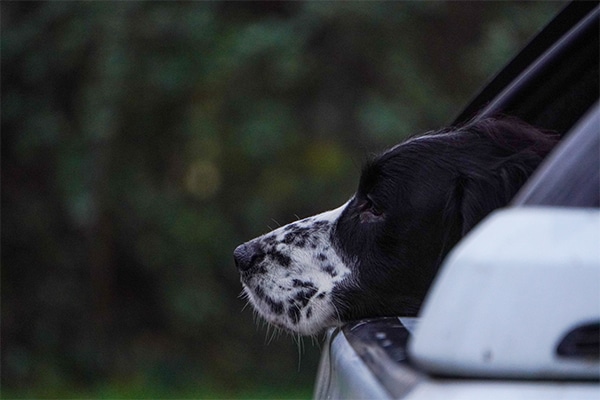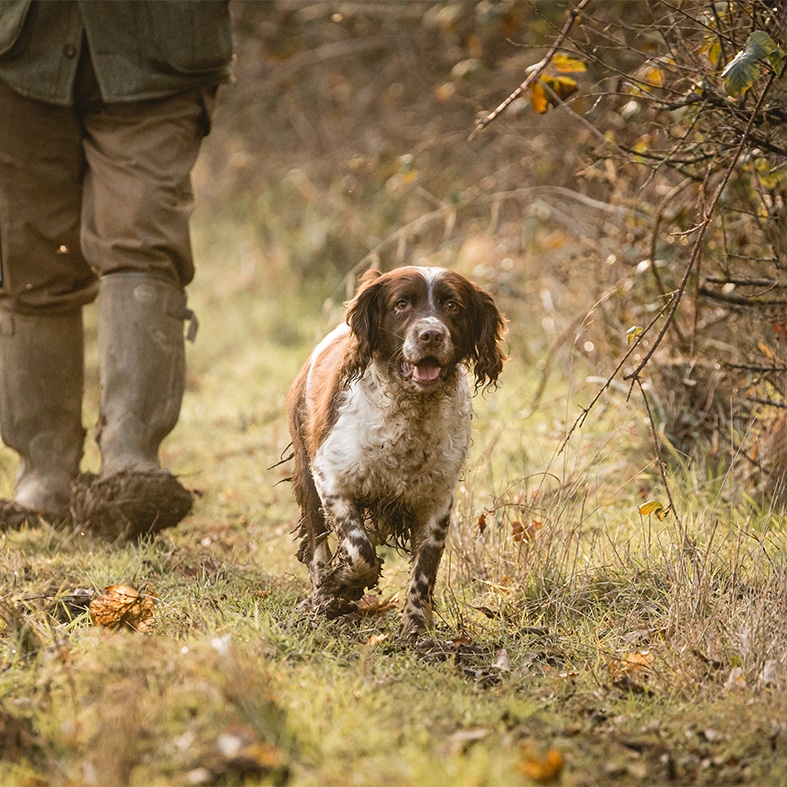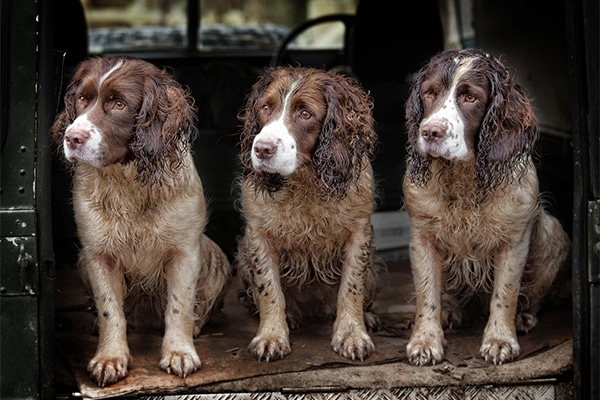
Gundog advice
Whether you are new to owning and training gundogs, or want more practical advice we’ve got you covered.
Get information on the legal shooting season for mammals and birds in the UK.
Apply for funding for your project or make a donation today
Comprehensive information and advice from our specialist firearms team.
Everything you need to know about shotgun, rifle and airgun ammunition.
Find our up-to-date information, advice and links to government resources.
Everything you need to know on firearms law and licensing.
All the latest news and advice on general licences and how they affect you.


Home » Gundogs » Gundog advice » Tail docking
The docking of a dog’s tail is a practice which has been carried out for centuries, primarily in order to avoid tail damage and for hygiene. There are two methods of docking:
The removal of the tails from litters of puppies less than five days old to prevent damage later in life, as a direct consequence of the type of work this type/breed of dog is recognised and required to carry out.
Is the removal of a diseased or damaged tail from a dog of any age for clinical reasons. Often needed for complete tail paralysis, tail tumours and other medical reasons. Therapeutic docking is carried out under general anaesthetic.
There are over fifty breeds of dog, which have had their tails docked, since the inception of the breed. Working gundog and terrier breeds have their tails docked as puppies to avoid injuries to the tail during their working life.
In recent years laws have been introduced in England, Wales and Northern Ireland restricting tail docking of dogs.
The Animal Welfare Act 2006 contains a general ban on the tail docking of dogs and the limited exemptions to it.
There are exemptions from the ban for certain types of working dog, or where docking is performed for medical treatment. The exemption allows certain types of working dog to have their tails docked by a veterinary surgeon.
The dog has to be no more than five days old.
The veterinary surgeon must certify that he or she has seen evidence that the dog is likely to work in one of the specified areas.
Download a sample tail docking certificate.
In England:
Any spaniel, terrier, hunt point retrieve breed or their crosses can be docked (as long as the necessary evidence indicating that they are likely to work is produced).
The puppy must be presented with the dam, and a statement provided by the owner (or the owner’s representative) that the dog is intended to work in one of the specified areas below.
Additional evidence related to the particular type of work the dog will perform is also required. It is crucial that members take all available paperwork with them when they go to the vet, including printouts of the document below together with the proofs of working status etc.
(a) law enforcement,
(b) activities of His Majesty’s armed forces,
(c) emergency rescue,
(d) lawful pest control, or
(e) the lawful shooting of animals
Additional evidence
A current shotgun or firearm certificate issued to the owner of the dog, or to the agent or employee of the owner most likely to be using the dog for work in connection with the lawful shooting of animals OR
A letter from a gamekeeper, a land occupier (or his agent), a person with shooting rights, a shoot organiser, a club official, or a person engaged in lawful pest control, stating that the breeder of the dog whose tail is to be docked is known to him and that dogs bred by that breeder have been used (as the case may be) on his land, or in his shoot, or for pest control.
A dog whose tail has been wholly or partly removed on or after 6 April 2007 may not be shown at any shows in England where the public are charged a fee for admission, irrespective of where the procedure took place.
However, a dog whose tail has been wholly or partly removed legally may be shown at an event where the public are charged a fee but only for the purpose of demonstrating its working ability and not for conformity to a standard.
Under the Welfare of Animals Act (Northern Ireland) 2011, it is illegal to dock the tail of any dog in Northern Ireland or to take a dog elsewhere to be docked.
There are exceptions with regard to the following working dog breeds; spaniels, terriers and any other breeds used for hunting, pointing or retrieving, or any combination of these breeds.
It is not an offence for:
A veterinary surgeon to dock a dog’s tail for the purpose of medical treatment;
An individual to dock a dog’s tail for the purpose of saving a dog’s life (where it is not reasonably practical for the procedure to be carried out by a veterinary surgeon).
A veterinary surgeon will require evidence to be provided by the owner or a representative of the owner. The veterinary surgeon may then dock a dog of the relevant breed not more than five days old.
The evidence required is:
a) The dam of the dog, or a veterinary certificate if the dam has died since whelping,
b) A completed statement (section one of the tail docking certificate), signed and dated from the owner of the dog or their representative (a certificate is included in the schedule of the regulations and can be downloaded below);
Download a NI Tail Docking Certificate here.
and
c) One of the following:
i. police identification,
ii. prison service identification,
iii. HMRC identification,
iv. Evidence that the owner or agent or employee of the owner most likely to be using the dog will be using the dog for lawful pest control,
v. A current firearm certificate issued to the owner of the dog or to the agent or employee of the owner most likely to be using the dog for work in connection with the lawful shooting of animals,
vi. A letter from
aa) a gamekeeper;
bb) a land occupier (or their agent);
cc) a person with shooting rights;
dd) a shoot organiser;
ee) a club official; or
ff) a person engaged in lawful pest control,
The letter must state that the breeder of the dog whose tail is to be docked is known to him or her and that the dogs bred by that breeder have been used on his or her land, on his or her shoot or for pest control.
It is important to make sure that you take all the evidence with you when you visit the vet. Upon receiving the evidence, the veterinary surgeon will complete section two of the tail docking certificate.
Dogs which have been docked must be microchipped before the dog is eight weeks old at the same veterinary practice which carried out the tail docking procedure.
If the veterinary practice has ceased to operate, the dog may be taken to another practice and the reason for the change in practice must be recorded on the certificate.
The owner or representative of the owner must sign and date section three of the tail docking certificate before the dog is microchipped.
Section four of the certificate is completed by the veterinary surgeon.
A dog whose tail has been wholly or partly removed before 1 January 2013 may continue to be shown at all shows in Northern Ireland for the remainder of its natural life.
A dog whose tail has been wholly or partly removed on or after 1 January 2013 may not be shown at any shows in Northern Ireland where the public are charged a fee for admission, irrespective of where the procedure took place.
However, a dog whose tail has been wholly or partly removed legally may be shown at an event where the public are charged a fee but only for the purpose of demonstrating its working ability and not for conformity to a standard.
Further information:
Animal Welfare (Northern Ireland) Act 2011
NI Docking of Working Dogs Tails Regulations
As of June 2018, Scottish law now permits ‘tail shortening by a third’ for the ‘lawful shooting of animals’.
The law permits this procedure for spaniels or any mix of breeds of spaniels (i.e. sprockers) and HPR breeds and any mix of hunt, point, retrieve breeds.
The procedure must be undertaken by a veterinary surgeon on pups aged five days or less. Evidence must be produced to indicate that the puppies are intended for the ‘lawful shooting of animals’, and a certificate is required for each puppy tail docked.
The dam’s microchip number is required for the certificate, and the pups may be ‘chipped’ at the same time as tail shortening.
Although tail docking is banned in Scotland any dog whose tail has been wholly or partly removed legally in England, Wales, and Northern Ireland or abroad may continue to be shown at any show in Scotland.
The Animal Welfare Act 2006 contains a general ban on the tail docking of dogs and the limited exemptions to it.
The docking of dogs’ tails has been banned in Wales since 27 March 2007 with exemptions from the ban for certain types of working dog. If you own a working dog which has had its tail docked you will need to make sure that this had been done in accordance with the regulations.
The exemption allows certain types of working dog to have their tails docked by a vet.
In Wales, the dog will have to be of a certain type in order to be docked. They are:
The puppy must be presented with the dam, and a statement provided by the owner (or the owner’s representative) that the dog is intended to work in one of the specified areas below.
Additional evidence related to the particular type of work the dog will perform is also required. It is crucial that members take all available paperwork with them when they go to the vet, including printouts of the document below together with the proofs of working status etc.
(a) law enforcement,
(b) activities of His Majesty’s armed forces,
(c) emergency rescue,
(d) lawful pest control, or
(e) the lawful shooting of animals.
Additional evidence
A current shotgun or firearm certificate issued to the owner of the dog, or to the agent or employee of the owner most likely to be using the dog for work in connection with the lawful shooting of animals, OR
A letter from a gamekeeper, a land occupier (or his agent), a person with shooting rights, a shoot organiser, a club official, or a person engaged in lawful pest control, stating that the breeder of the dog whose tail is to be docked is known to him and that dogs bred by that breeder have been used (as the case may be) on his land, or in his shoot, or for pest control.
A dog whose tail has been wholly or partly removed before 28 March 2007 may continue to be shown at all shows in Wales for the remainder of its natural life.
A dog whose tail has been wholly or partly removed on or after 28 March 2007 may not be shown at any shows in Wales where the public are charged a fee for admission, irrespective of where the procedure took place.
However, a dog whose tail has been wholly or partly removed legally may be shown at an event where the public are charged a fee but only for the purpose of demonstrating its working ability and not for conformity to a standard.
In partnership with

Whether you are new to owning and training gundogs, or want more practical advice we’ve got you covered.

The key to training a gundog is to make sure that training sessions are enjoyable for both you and your dog.

BASC strongly recommends that anyone who goes shooting should be accompanied by a trained and competent gundog.
Sign up to our weekly newsletter and get all the latest updates straight to your inbox.
© 2025 British Association for Shooting and Conservation. Registered Office: Marford Mill, Rossett, Wrexham, LL12 0HL – Registered Society No: 28488R. BASC is a trading name of the British Association for Shooting and Conservation Limited which is authorised and regulated by the Financial Conduct Authority (FCA) under firm reference number 311937.
BASC Direct Ltd is an Introducer Appointed Representative of Agria Pet Insurance Ltd who administer the insurance and is authorised and regulated by the Financial Conduct Authority, Financial Services Register Number 496160. Agria Pet Insurance is registered and incorporated in England and Wales with registered number 04258783. Registered office: First Floor, Blue Leanie, Walton Street, Aylesbury, Buckinghamshire, HP21 7QW. Agria insurance policies are underwritten by Agria Försäkring.
If you have any questions or complaints about your BASC membership insurance cover, please email us. More information about resolving complaints can be found on the FCA website or on the EU ODR platform.